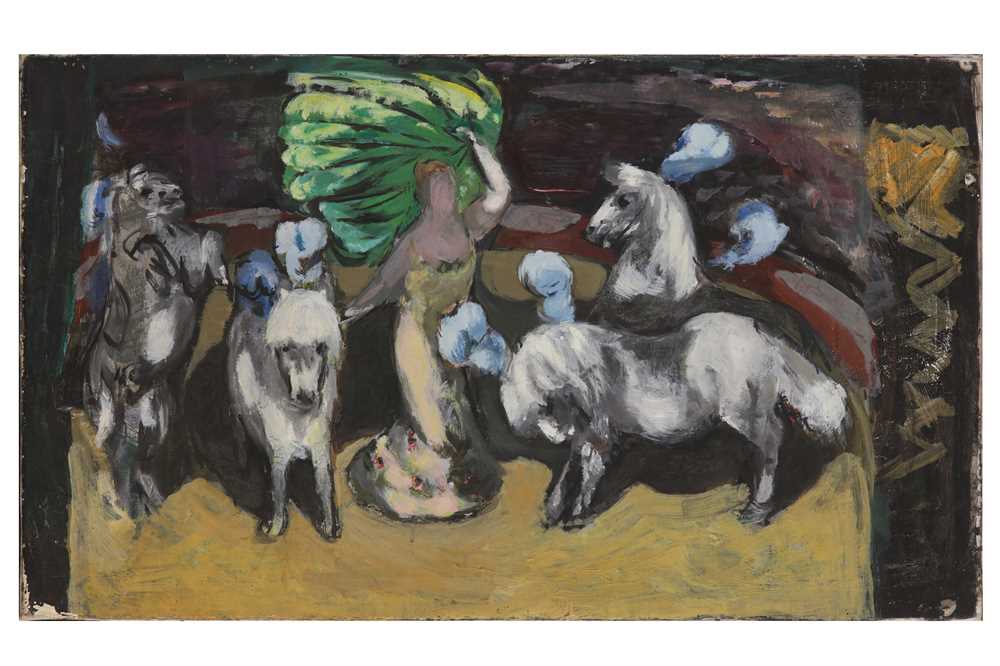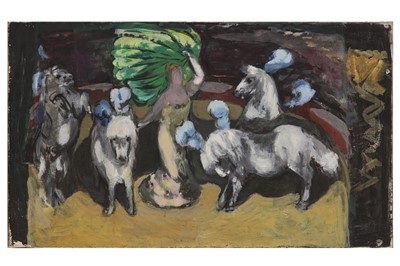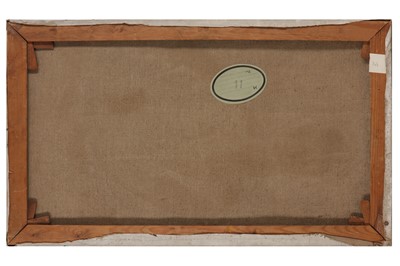4th Dec, 2020 14:00
British & European Fine Art | Live Online
MARIE-LOUISE VON MOTESICZKY (AUSTRIAN 1906 - 1996)
Property from the Marie-Louise von Motesiczky Charitable Trust
MARIE-LOUISE VON MOTESICZKY (AUSTRIAN 1906 - 1996)
Circus Scene
oil on canvas
53.6 x 90.3 cm (21 x 35 1/2 in)
LITERATURE:
Ines Schlenker, Marie-Louise von Motesiczky 1906-1996, A Catalogue Raisonné of the Paintings, New York, 2009, p. 333, no. 192, illustrated
Painted in 1964, according to Ines Schlenker, the present work is thought to have been inspired by a circus performance attended by the artist, and loosely based on three photographs taken at the time (now in the collection of the Motesiczky Archive at Tate; fig.1). Dramatically lit, the equestrian act takes place in a claustrophobically small arena. In the centre the striking female trainer, dressed in a full length evening gown with low neckline, flourishes a huge green feather boa over her head as she commands to great theatrical effect the stamping and rearing ponies beside her. Stark lighting illuminates and isolates the scene, casting deep shadows around the circus ring, while the dusky blues of the plumes that decorate the horses’ heads contrast with the violent green and yellow of the central figure’s boa to create an image that combines excitement and energy with an underlying edge of mystery.
Property from the Marie-Louise von Motesiczky Charitable Trust (lots 820 - 827)
Viennese emigré artist Marie-Louise von Motesiczky (1906-1996) parted with few of her works during her lifetime, and since her death less than a handful have appeared on the open market. Lots 820 - 827 span four decades - from 1945 to the early 1980s - and mark the first time a group of her paintings is to be offered at auction.
Marie-Louise lived in Vienna until the Anschluss in 1938, when Austria was annexed by Germany and she and her Jewish mother were forced to emigrate to England in 1939. The primary influence on her art was the German painter Max Beckmann whom Marie-Louise had first met in her early ‘teens in 1920. She recalled: ‘A winged creature from Mars could not have made a greater impact on me’. From the early 1920s, she attended classes in different studios across Europe and she and Beckmann kept in regular contact. He visited her in Paris, and she accepted his invitation to attend his masterclasses in Frankfurt.
During these formative years Marie-Louise enjoyed a privileged life. Her mother Henriette was scion of an illustrious Viennese Jewish banking dynasty. Her maternal grandfather, Leopold von Lieben, was President of the Stock Exchange; her grandmother, Anna, one of Freud’s early patients. She counted the Todescos, and Ephrussis among her family circle. Growing up in an apartment on Brahmsplatz in central Vienna, she, her mother and her brother Karl spent their summers at Villa Todesco in Hinterbrühl, south west of the capital.
But over time family tragedy, financial difficulties and above all the rise of Nazi Germany took their toll. Marie-Louise’s father had died in a hunting accident many years before and her mother’s considerable inheritance gradually diminished through a combination of high taxation, ill-advised investments, and the financial crash of 1929. Then, with the rise of the Third Reich she and her mother felt compelled to flee Austria. Further distress followed when her brother Karl, who had remained in Austria, was arrested and deported to Auschwitz, dying of typhus there on 25 June 1943.
Immediately following the Anschluss Marie-Louise and her mother travelled to Holland where she renewed contact with Beckmann, living in Amsterdam. Then, in January 1939, she and her mother emigrated to Britain. In London she reconnected with Oskar Kokoschka, a family friend in Vienna but now similarly exiled. Kokoschka ensured that her work was shown in a series of group exhibitions, culminating in a one-person exhibition at the Czechoslovak Institute in the autumn of 1944.
Whilst on the Continent Beckmann had informed Marie-Louise’s distinctive aesthetic, evident in her use of bold compositional forms, commanding characterisation, strong lighting and vivid colours. But in London Kokoschka’s influence also began to infuse Marie-Louise’s work. Her palette softened, her brush strokes became lighter and more feathery, and the gestures of her sitters less angular and severe. Her more tempered approach suited the increasingly thoughtful, enigmatic, and poetic narratives that typified her post-war canvases.
Despite Kokoschka’s support, however, starting afresh in Britain proved challenging. Marie-Louise commented in an interview in 1952: ‘It is a very difficult scene for foreigners.’ Thus, it wasn’t until 1960 that she had her next one-person show at the influential Beaux Arts Gallery. Yet, bar a positive review by J.P Hodin, it received mixed reviews. It was to be a further 25 years before she had another solo exhibition in the capital.
Meanwhile, on the Continent Marie-Louise’s reputation was growing. She received wide acclaim when her work was exhibited in Amsterdam and The Hague in 1952, one of her canvases being purchased by the Stedelijk Museum. And when she showed in Munich in 1954 and Düsseldorf the following year. In the 1960s also she enjoyed further solo shows in Austria and Germany.
Then, in 1985, her work was shown again in London at the Goethe-Institut. It coincided with the Royal Academy’s major retrospective German Art in the Twentieth Century. Widely acclaimed in the press in the UK and abroad, finally it seemed the climate was favourable for the re-discovery of Marie-Louise’s art.
Further exposure followed. In 1994 she was the subject of a major retrospective in Vienna at the Osterreichische Galerie, Oberes Belvedere and in Manchester at the City Art Gallery. In 2006-07 her work was shown in a centenary exhibition at Tate Liverpool, and travelled to Frankfurt, Vienna and Passau, ending in Southampton City Art Gallery. In 2007 Jill Lloyd’s biography of Marie-Louise appeared, followed in 2009 by the catalogue raisonné of her paintings by Ines Schlenker. Most recently, in the autumn of 2019, Tate Britain held an exhibition devoted to her to inaugurate the gallery named in perpetuity as the ‘Marie-Louise von Motesiczky Archive Gallery’ for all future displays of Tate’s archive holdings in general.
The work of Marie-Louise von Motesiczky held in public collections
Institutions in the UK holding paintings and works on paper by the artist include: the British Museum, Freud Museum, National Portrait Gallery and Tate in London (which also holds her archive); the Fitzwilliam Museum, Cambridge, New Walk Museum and Art Gallery, Leicester, Manchester Art Gallery, National Galleries of Scotland, Edinburgh and the Hunterian Art Gallery, Glasgow. Elsewhere her work is in the National Gallery of Ireland, Dublin; the Stedelijk, Amsterdam; the Boijmans van Beuningen Museum, Rotterdam; the Städel Museum, Frankfurt; the German Literary Archive in Marbach; the Albertina, Österreichische Galerie Belvedere, the Leopold Museum and the Museum Wien in Vienna, and the Lentos Kunstmuseum. Linz.
The Marie-Louise von Motesiczky Charitable Trust
The Marie-Louise von Motesiczky Charitable Trust, is a company limited by guarantee registered in England and Wales (no. 7572024) and a registered charity (no. 1140890): www.motesiczky.org. The copyright for Marie-Louise von Motesiczky’s paintings, drawings and sketches lies with the Marie-Louise von Motesiczky Charitable Trust.
Sold for £8,125
Includes Buyer's Premium
Do you have an item similar to the item above? If so please click the link below to request a free online valuation through our website.


